MARIANI’S
Virtual
Gourmet
January 14,
2018
NEWSLETTER
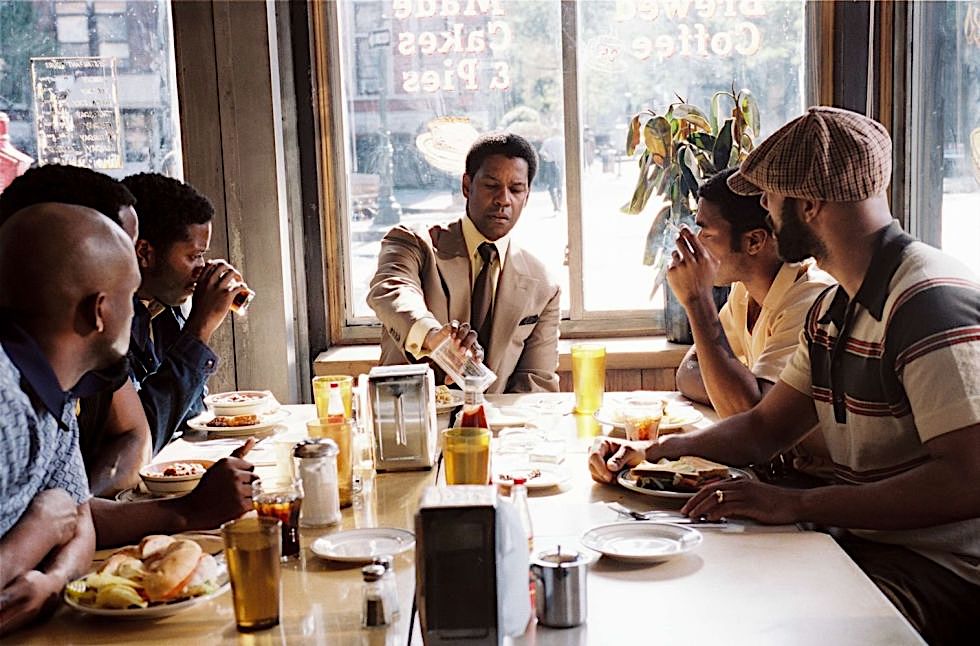
"AMERICAN GANGSTER" (2007)
IN THIS ISSUE
DINING OUT BEFORE AND
AFTER THE SUPER BOWL
IN THE TWIN CITIES
By John Mariani
NEW YORK CORNER
DEMARCHELIER
By John Mariani
NOTES FROM THE WINE CELLAR
ROSÉ CHAMPAGNES FOR VALENTINE'S DAY
By Geoff Kalish
❖❖❖
DINING OUT BEFORE AND
AFTER THE SUPER BOWL
IN THE TWIN CITIES
By John Mariani
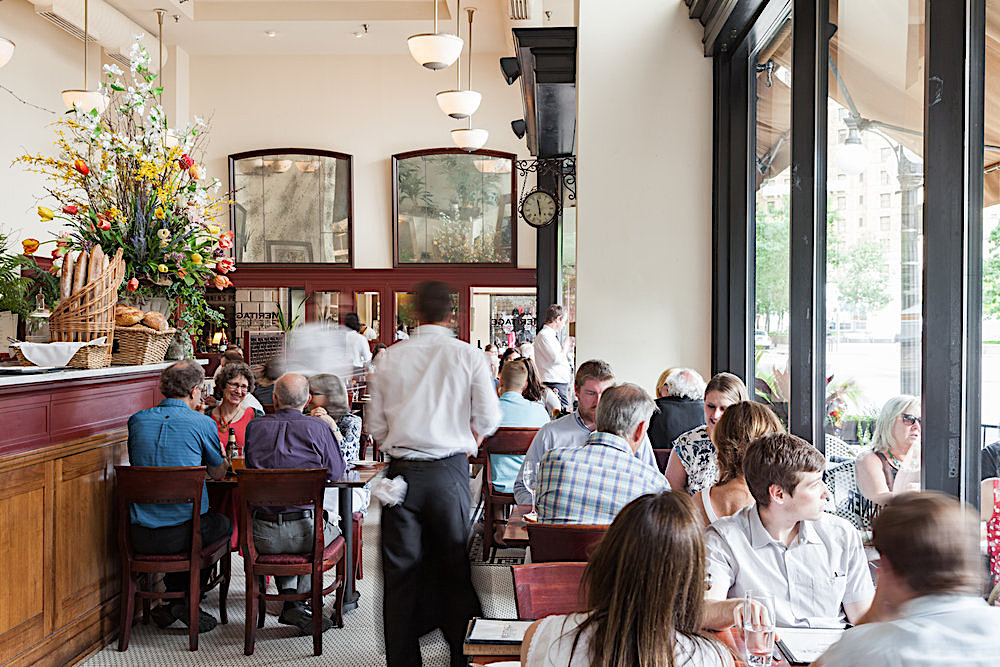
Meritage, St. Paul
Minneapolis’s food
scene has received far more attention than St.
Paul’s from food media seeking news out of the
Midwest, with much of the attention focused on
the return of hometown boy Gavin Kaysen to open
the oddly named Spoon and Stable. Yet
there is a great deal more happening in both
cities,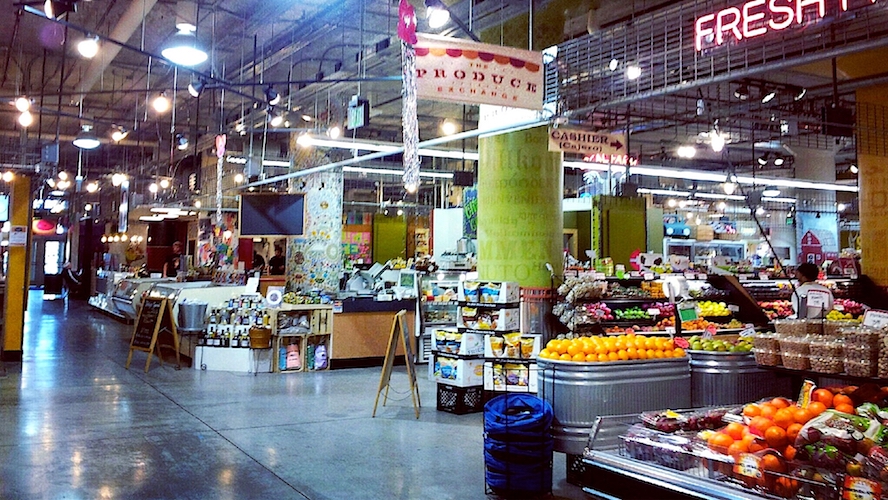 not
least in Asian and African eateries.
not
least in Asian and African eateries.
I’m sad that so many of the old-time restaurants that once reflected the Twin Cities’ immigrant heritage are gone, like Ernie’s Scandinavian and Nye’s Polonaise—though Black Forest Inn lives on—but you can get a taste of the cities’ culinary depth at the huge Midtown Global Market (right), whose stalls manifest just about every ethnic cuisine you’d seek, from Holy Land Grivery, Butcher Shop & Deli and Taqueria Los Ocampo to Moroccan Flavors and Hot Indian Foods.
During my time in the Twin Cities I ate splendidly
from morning till night. Here’s what I liked, and
what you may want to try if you’re going to next
month’s Super Bowl.
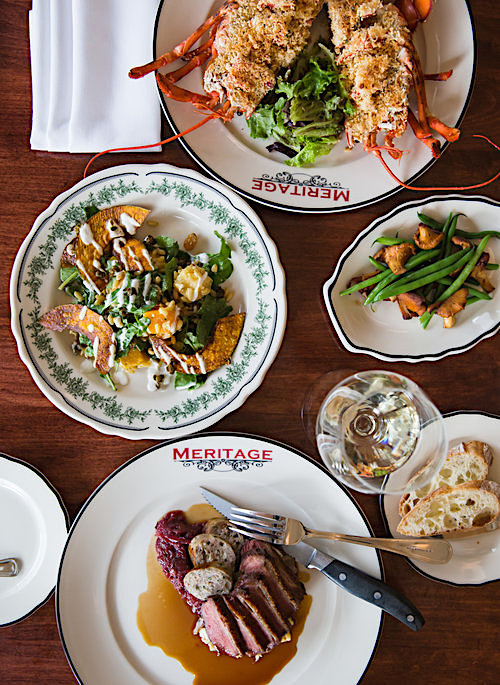 MERITAGE
MERITAGE
410 St. Peter Street
St. Paul
651-222-5670
Meritage, whose named refers
to a union of “merit” and “heritage,” looks very
close to a true Parisian brasserie, modern while
wearing its original 1919 décor well. Chef
Russell Klein, a native New Yorker, and his wife,
Desta Maree, from Mississippi (below), who
as Wine Director oversees the wine program and
school, are celebrating the restaurant’s tenth
anniversary, and for the past two years 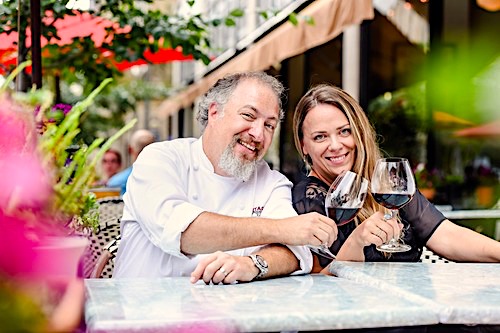 the restaurant has won MSP
Magazine’s “Reader’s Choice as the Best
Restaurant” in the Twin Cities. That kind of
accolade is owed not just to the quality of food
at Meritage but to the comfort and cosseting
guests receive upon arrival, during dinner and at
departure. It is palpable that the Kleins love
what they do. And Russell's training at New York’s
La Caravelle and Bouley is evident in every dish.
the restaurant has won MSP
Magazine’s “Reader’s Choice as the Best
Restaurant” in the Twin Cities. That kind of
accolade is owed not just to the quality of food
at Meritage but to the comfort and cosseting
guests receive upon arrival, during dinner and at
departure. It is palpable that the Kleins love
what they do. And Russell's training at New York’s
La Caravelle and Bouley is evident in every dish.
It’s a beautiful space, beginning with an oyster bar and moving into a high-ceilinged room with tilted mirrors, tile floors, an effusion of flowers, and lantern chandeliers. It’s the kind of place to celebrate something as much as a favorite spot you go to when you need a bistro-fare fix.
I let Russell cook whatever he wished for me. Dish after dish emerging from the kitchen had exactly the right look that revered French classics should have, but more important were the superb flavors involved, from an intense onion soup gratinée ($12.50) as good as any I’ve had in Paris to a shooter of billi bi ($4), a creamy saffron-scented mussel soup not much seen on menus any more but deserving of a return to eminence. A puff of foie gras ($3.50) made for a good amuse.
 I then
moved on to impeccably cooked, juicy sturgeon
roasted in duck fat
with sweetbreads, celeriac, wild mushrooms,
apple and a beautiful red wine reduction ($37). Then
came another French classic that was once
ubiquitous on menus and is now in recession:
Tournedos Rossini, that over-the-top layering of
rare filet mignon with seared Minnesota foie gras
in a lush Madeira sauce and a shower of black
truffles ($68).
I then
moved on to impeccably cooked, juicy sturgeon
roasted in duck fat
with sweetbreads, celeriac, wild mushrooms,
apple and a beautiful red wine reduction ($37). Then
came another French classic that was once
ubiquitous on menus and is now in recession:
Tournedos Rossini, that over-the-top layering of
rare filet mignon with seared Minnesota foie gras
in a lush Madeira sauce and a shower of black
truffles ($68).
Like many, I grew so tired of
this continental cliché always being so poorly
made, but Meritage’s version revived in me
everything that made it so wonderful in the first
place. You
might as well also order the piping hot frites
($9.50) and share them at the table. Every
dish here is beyond generous.
For dessert the almond sponge-and-chocolate opera cake is the way to go (left).
One of the great joys of my job is finding places like Meritage where I least expect them, so that I can say with little fear of contradiction, this is easily one of the finest French restaurants in the United States.
TILIA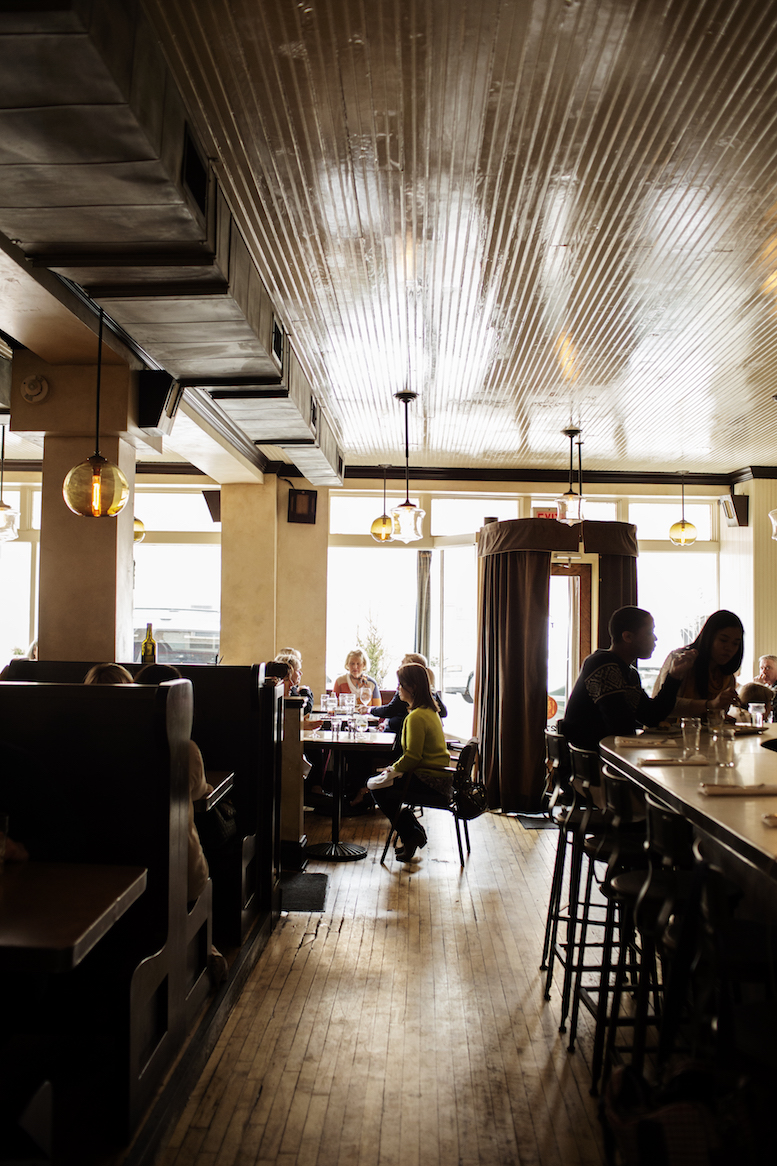
2726 West 43rd Street
Minneapolis
612-354-2806
Photos by Bill Phelps
On my first bitter cold night in Minneapolis, this warm, 50-seat gastro-pub was just what I needed, a place to slump into a booth and chat with owner-chef Steven Brown about the food scene in town, which is thriving in the casual sector, where price is a prime consideration in people’s choice of where to eat.
Tilia’s success has as much to do with its drop-in
atmosphere and very friendly young staff as with a
menu aiming to please a wide range of people, from
those who just come for a cheeseburger—a towering
edifice with tiger sauce mayo, griddled onions,
cheese and dill pickles ($13)—and a local beer
called Surly, to those who begin with a striped
bass crudo
with avocado, pistachio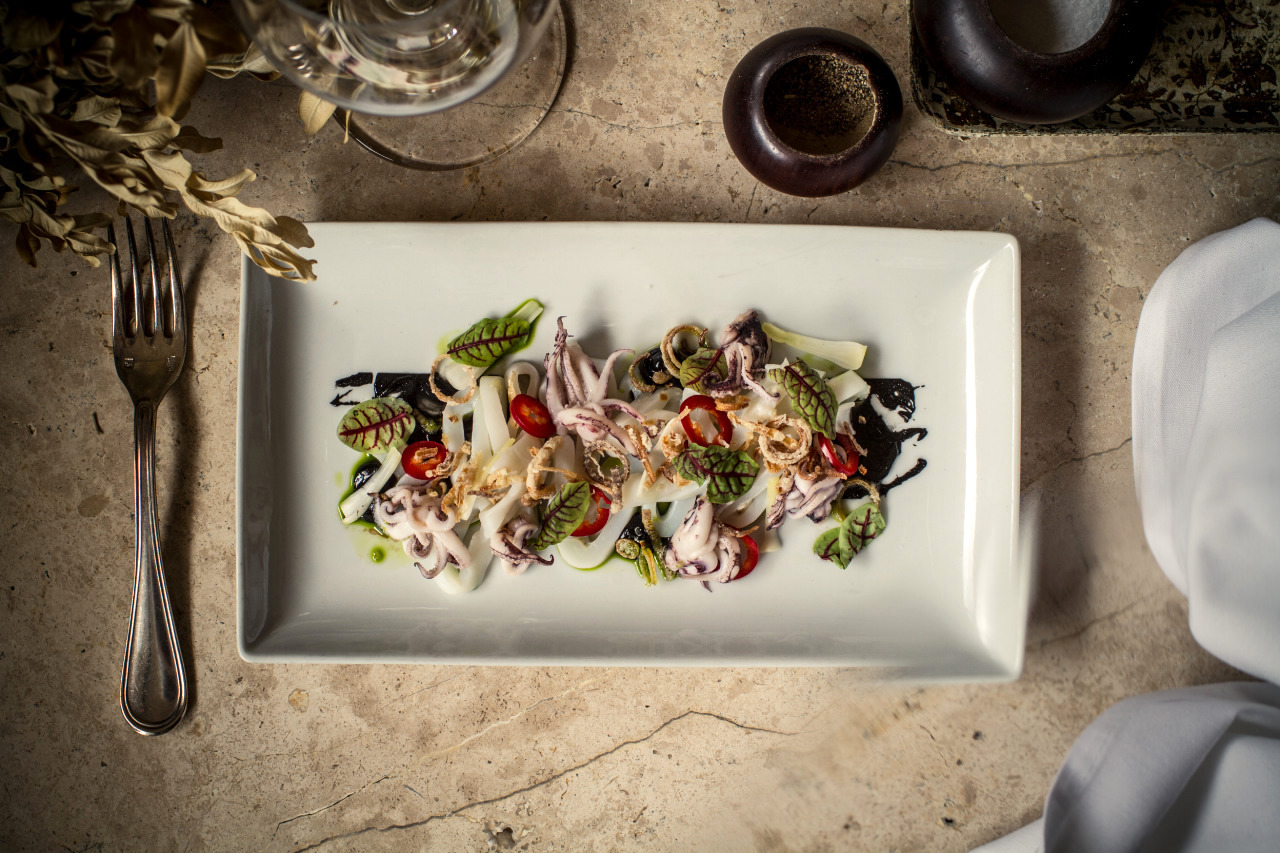 and lime
($15) and a delicious, creamy chicken liver mousse
with a fried baguette ($10) and a bottle of wine.
and lime
($15) and a delicious, creamy chicken liver mousse
with a fried baguette ($10) and a bottle of wine.
Sadly, Tilia has no liquor license, but it does have a dream list of well-chosen wines under $70, with a multitude by the glass.
The best of the pastas I tried were plump agnolotti stuffed
with butternut squash, sage, sorghum and blue
cheese ($25), but I winced at Brown’s sprinkling
fennel pollen on that simplest of Roman pastas, cacio e pepe
($19). Most of all I liked the pan-roasted chicken
thighs, a nice meaty portion, that retained its
pan juices, along with polenta, baby onions,
olives and the sweetness of figs ($27).
The desserts ($7-$9) I
tried—butterscotch pot de crème, honey cake with
crisp apple, and a chocolate tart with pretzel,
smoked salt and caramel—were perfect for a
freezing night when you want to linger at Tilia as
long as you can.
ZEN BOX IZAKAYA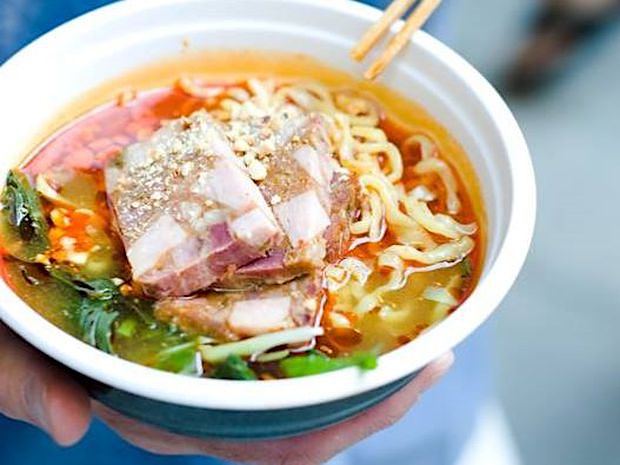
602 Washington Avenue South
Minneapolis
612-332-3936
Minneapolis
hasn’t a heck of a lot of good restaurants open
for lunch, so it’s easy enough to see why Zen Box
Izikaya is always full. Beyond its convenience,
however—and it’s near U.S. Bank Stadium—the real
draw is the tantalizing Japanese and Asian
food and the engaging personalities of
wife-and-husband owners Lina Goh and John Ng, who
opened Zen Box in 2012 with a riot of colors,
Japanese calligraphy and Japanese toys arrayed
along the counter.
and Asian
food and the engaging personalities of
wife-and-husband owners Lina Goh and John Ng, who
opened Zen Box in 2012 with a riot of colors,
Japanese calligraphy and Japanese toys arrayed
along the counter.
Lina is out front, greeting, coaxing, making sure
you’re happy, and John and his crew are turning
out a broad menu that ranges from excellent tuna
poke ($11.50) and a ramen box ($13-$14) to all kinds of novel
ideas like avocado tempura with a spicy mayo ($8)
and fabulous Korean-style short ribs with skewered
tofu ($6). One of the most rightly popular dishes
is the chasu
yaki ($8.50), a bowl of thick, succulent
pork belly with onions and ponzu
sauce.
to all kinds of novel
ideas like avocado tempura with a spicy mayo ($8)
and fabulous Korean-style short ribs with skewered
tofu ($6). One of the most rightly popular dishes
is the chasu
yaki ($8.50), a bowl of thick, succulent
pork belly with onions and ponzu
sauce.
Everything is beautifully and colorfully presented and most dishes can happily be shared; the low prices mean you can order up a storm with friends and still not feel light in the wallet. It would be easy enough to eat at Zen Box twice a week and it might still take a month to work your way through the entire menu. And every time you come through the door, Lina will be there to welcome you back.
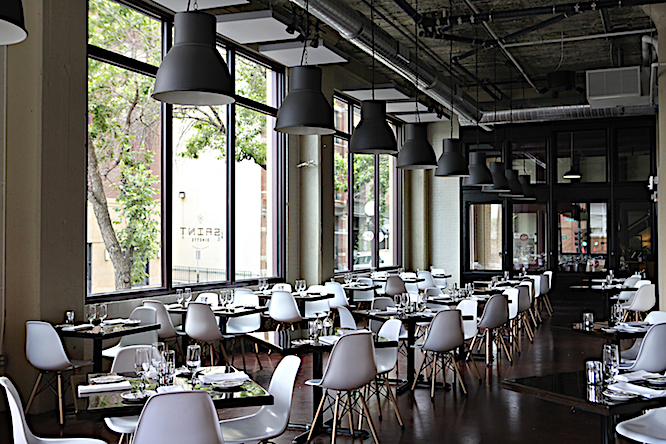
SAINT DINETTE
261 East 5th Street
St. Paul
651-800-1415
Located
in what’s called Lowertown, Saint Dinette is
devoted largely to a small plate menu, though, as
you might imagine, plates in Minnesota are quite a
bit larger than they might be on the coasts. And the
ingredients themselves are gathered largely from
the region from the St. Lawrence  and Great Lakes to the Mississippi
and down to Louisiana by Chef Adam Eaton.
and Great Lakes to the Mississippi
and down to Louisiana by Chef Adam Eaton.
One of the best dishes I had all last year was the
bone marrow (right),
which of itself is a nice idea but by adding
corned beef, sauerkraut, Russian dressing and
Swiss cheese ($12) to it, it becomes a
tantalizingly delicious concept. There is so much
on the menu that delivers big flavors, from tender
octopus with patatas
bravas, piquillo
peppers and the acidic bite of aïoli ($14) to
first-rate fried chicken—Nashville style, but not
overpoweringly hot ($18)--with crisp skin that
doesn't fall off the meat. Have a well-made
cocktail and nibble on the charred shishito
peppers (below)
made like a Caesar salad with bonito flakes ($8).
The pappardelle
combines with a lusty venison and wild boar ragù ($15).
The Midwestern staple of bologna and American
cheese and pickles is cute idea but 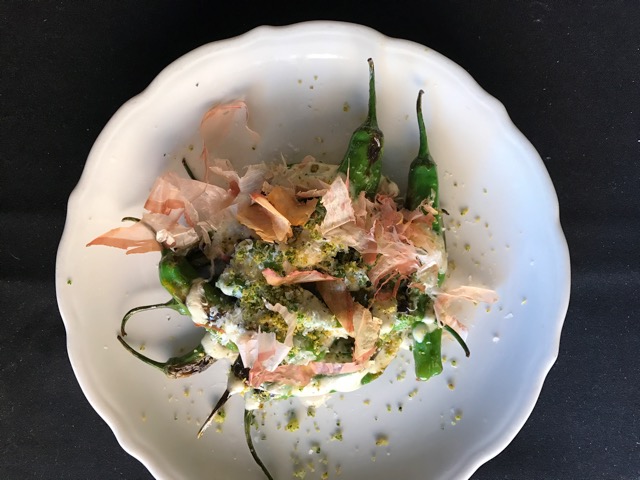 not a very savory one
($11).
not a very savory one
($11).
The welcome-back cream
cheese-frosted carrot cake ($8) was a delight and
not overly sweet. Then
again, who'd argue with the suggestion of
flapjacks with vanilla butter and Canadian maple
syrup ($8) for dessert?
To put it simply and
admirably, Eaton is a damn fine cook--which is
every bit as important as being an overseer
chef--who never overdoes the seasonings and makes
new ideas from old ones come alive.
From the outside, through tall windows, Saint Dinette looks like a place to have a fine meal without fuss. The decor is minimal, semi-industrial and gray, but the sunlight at daytime and shadows at night give it a duality of style and ambiance. Inside the care taken by manager Laurel Elm and owner-partner Tim Niver make this a place you’ll tell others about and want to bring them back to.
❖❖❖
By John Mariani
DEMARCHELIER
50 East 86th Street
212-249-6300
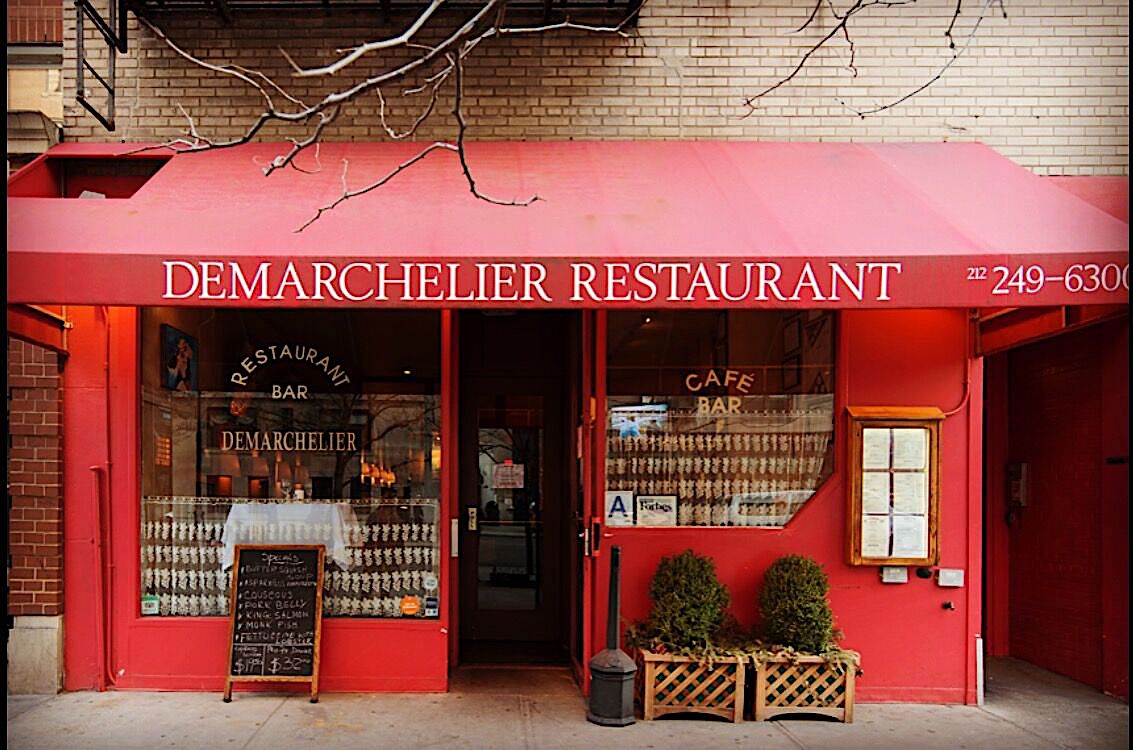
A
good family-owned French bistro is a pleasure at
any time of the year, but right now, with the
winds of winter whipping their way through every
body and soul, the idea of pulling open the door
of a warm, cozy spot like Demarchelier puts most
other restaurants out of mind.
Since 1978, originally on Lexington Avenue but
for the past 25 years located a mile north on
East 86th Street, Demarchelier has been a
fixture of the Upper East Side, and, according
to our waiter, probably 70 percent of the
clientele on any given night are locals and
regulars.
Most who come through the bistro’s red
door are greeted by name.
They come for the bonhomie, the
cordiality and the honest cooking that have always
been the hallmarks of a place that looks plucked
right from Montparnasse, from its crimson façade
and awning and butter yellow walls and lace
curtains to its brown banquettes, brass railings
and tilted mirrors. Owner Eric Demarchelier’s
Picasso-Miró style paintings hang on the walls
(his brother is fashion photographer Patrick
Demarchelier) and you are likely to be greeted by
his daughter Emily, who serves as the genial
manager.
So, you hang your coat on a hook and sit down to a table set with linens topped with white paper. You get the menu and wine list right away and find a slew of apéritifs, wines by the glass—which include a good number of Bordeaux Supérieurs and Cru Bourgeois—beer, even cider. A very French waiter named Philippe tells you the night’s specials, and soon the cold weather is a distant memory as you break off a piece of good bread.
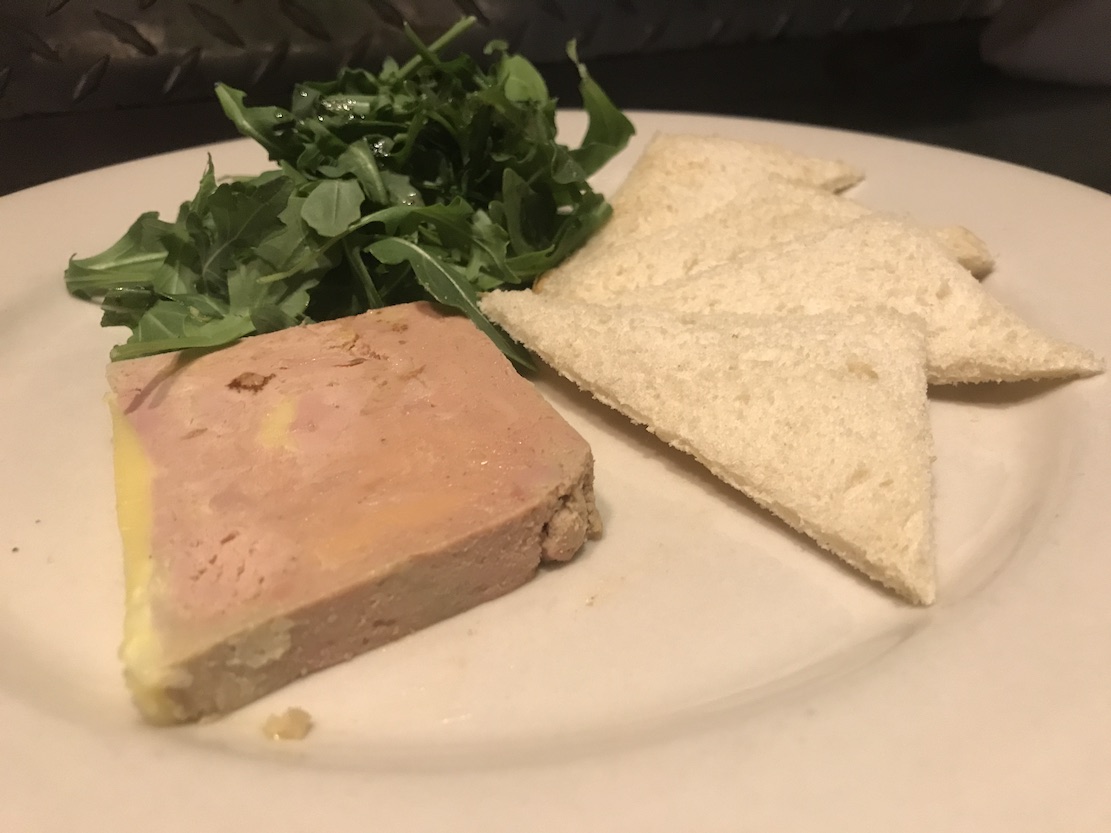 The
menu has changed little in four decades; it is a
compilation of bistro classics that never go out
of style, only out of fashion, and each night
there are additions that Chef Marc Tagournet
creates from
the day’s market.
The
menu has changed little in four decades; it is a
compilation of bistro classics that never go out
of style, only out of fashion, and each night
there are additions that Chef Marc Tagournet
creates from
the day’s market.
These are the kinds of dishes now made with ingredients far superior and far fresher than in 1978, when white mushrooms were all you could find and foie gras came out of a can. Now a chef can find an array of goat’s cheeses, excellent herring, and fresh foie gras (left), and Tagournet puts them to good use. His torchon of foie gras is creamy and very flavorful, served with what seems half a loaf of toasted bread. The pâté de campagne in a flaky crust is moist and textured ($12.75).
There is always a “quiche of the day” ($13.50),
which is almost always a quiche Lorraine, and it’s
the kind of dish you recall with fondness from
years ago, when it was the quintessential brunch
dish. But my favorite dish on a bitter cold night
was an impeccably made fondue (below), just
the right temperature, just the right texture,
made with white wine and three cheeses of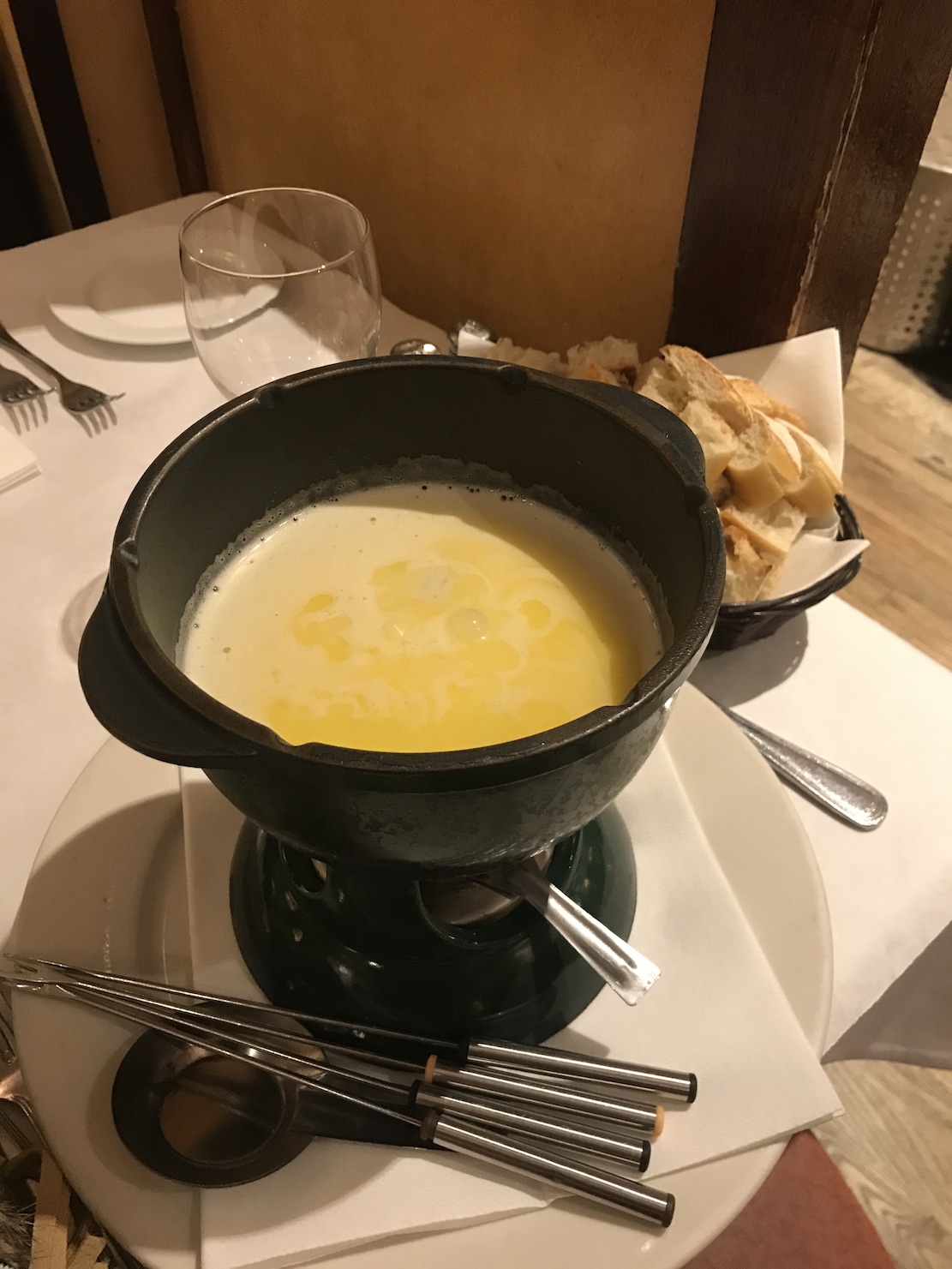 varying
intensity, including Comté, Gruyère and
Emmental. It’s another
dish that has faded in popularity, but not at
Demarchelier, where it sets a standard for rich,
gooey goodness. It comes in a half ($21.50) or
full portion ($38.50), and the four of us at our
table couldn’t stop sticking our bread-spiked long
forks into the molten mass until every last lick
of the fondue was gone.
varying
intensity, including Comté, Gruyère and
Emmental. It’s another
dish that has faded in popularity, but not at
Demarchelier, where it sets a standard for rich,
gooey goodness. It comes in a half ($21.50) or
full portion ($38.50), and the four of us at our
table couldn’t stop sticking our bread-spiked long
forks into the molten mass until every last lick
of the fondue was gone.
There are four beef cuts, steak tartare and two burgers offered, and my friend ordered steak frites with a grilled ribeye ($34.50), beautifully cooked, with both Béarnaise and peppercorn sauces; the frites showed how forty-plus years can add up to perfection.
Jumbo sea scallops ($38) of fine quality came with baked leeks and a moutarde à l’ancienne. A special of the evening was snow-white filet of cod with a pea puree that unfortunately had little flavor.
As at any true bistro, there are dishes served only one day a week—couscous, cassoulet, bouillabaisse, and so on. On the Wednesday night I visited Philippe told us as soon as he gave us the menu that the night’s canard à l’orange had gone fast—it was only 7 p.m.—with only one portion left, which I immediately claimed. It came crisp and had a not-too-sweet orange sauce (rather than a cloying glaze) but the meat was not very hot and had a slightly liverish flavor; perhaps ordering the last duck of the evening wasn’t such a great idea.
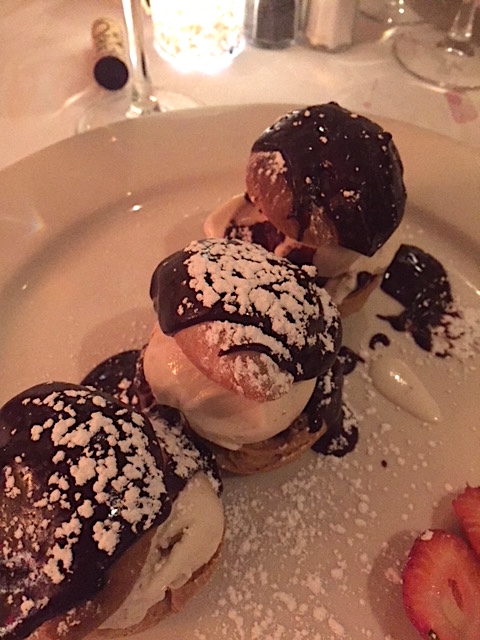 I asked our server to
choose four desserts, and every one was yet
another reminder of French bourgeois home cooking:
three fat profiteroles ($10; left), a
slice of decadent chocolate mousse cake
($10.50), a well-wrought crème brûlée ($8.75),
and—what a surprise!—crêpes Suzette au Grand
Marnier ($975), flamed with flourish right on the
plate.
I asked our server to
choose four desserts, and every one was yet
another reminder of French bourgeois home cooking:
three fat profiteroles ($10; left), a
slice of decadent chocolate mousse cake
($10.50), a well-wrought crème brûlée ($8.75),
and—what a surprise!—crêpes Suzette au Grand
Marnier ($975), flamed with flourish right on the
plate.
Before going to Demarchelier, I plucked a 1979
guide to French restaurants in NYC from my files;
there were a hundred of them, including once
popular, now closed bistros like Les Sans
Culottes, Frère Jacques, and La Cocotte. The guide
described Demarchelier thus: “For the young and
lovely, the lively bar and terrace tables are
favorite places to see and be seen.”
A
lot of Demarchelier’s old-time regulars are no
longer so young and lovely, although many of the
present generation that pack the place are, and it
is no longer a “see and be seen” sort of place. Instead,
it is a place to bask and be pampered, a link to
an authentic style of French bistro that is now
making a comeback in NYC, with the opening last
year of Little Frog and a re-opening of La Goulue.
Any young chef or restaurateur seeking a template
for what a bistro really is should pull back that
red door at Demarchelier and find out.
Demarchelier is open for lunch Mon.-Fri.; dinner nightly; brunch on Sunday.
by Geoff
Kalish

with Hermione
Gingold, Leslie Caron and Louis Jourdan
With
the rising popularity of pink wines as well as
bubbly it’s no wonder that most retail shops
are well stocked now for pre-Valentine’s Day
sales, especially rosé Champagne (the real
stuff from a demarcated area in France). Moreover,
many of these
bubblies offer enjoyment not only as romantic
toasts but also as mates for a wide range of
fare.
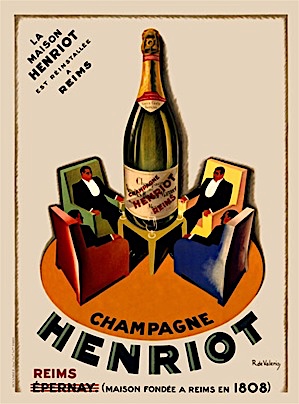 There is, however, many
a clunker out there, generally too fruity
and/or lacking enough refreshing acidity to
provide pleasure as a toast or with all but
sweet desserts.
So, as a guide to consumers, culled
from a series of tastings, particularly one
held recently by NYC’s Wine Media Guild (an
organization of professional wine
communicators), the following are my comments
on ten widely available, top-notch rosé
Champagnes for Valentine’s Day.
There is, however, many
a clunker out there, generally too fruity
and/or lacking enough refreshing acidity to
provide pleasure as a toast or with all but
sweet desserts.
So, as a guide to consumers, culled
from a series of tastings, particularly one
held recently by NYC’s Wine Media Guild (an
organization of professional wine
communicators), the following are my comments
on ten widely available, top-notch rosé
Champagnes for Valentine’s Day.
Collet
Brut Rosé ($48)
Made
of 40% Chardonnay, 50% Pinot Noir and 5% Pinot
Meunier, this non-vintage bubbly is a great
bargain. It shows a fresh, yet delicate bouquet
and taste of peaches and raspberries, with hints
of honey in its velvety finish – perfect to pair
with flavorful cheeses and grilled seafood.
Henriot
Brut Rosé ($57)
Fashioned
from 50% Pinot Noir, 45% Chardonnay and 5% Pinot
Meunier, this non-vintage 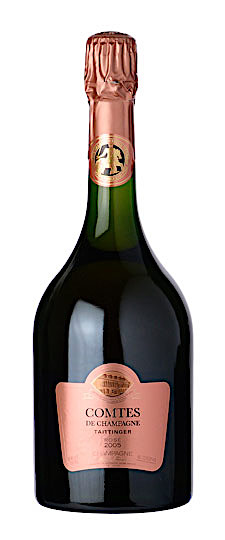 bubbly has a bouquet of
raspberries and a taste of black currants and
lime, with notes of anise in its elegant finish.
It makes a good mate for pasta with white sauce
as well as chicken and duck dishes.
bubbly has a bouquet of
raspberries and a taste of black currants and
lime, with notes of anise in its elegant finish.
It makes a good mate for pasta with white sauce
as well as chicken and duck dishes.
2006
Taittinger Comtes de Champagne Brut Rosé
($185)
One
of my all time favorite bubblies, this
effervescent wine contains 85% Chardonnay and
15% Pinot Noir. It shows a lush, ripe cherry and
cranberry bouquet and taste with hints of
toasted hazelnuts and orange peel and a lush,
silky finish. This wine makes a perfect mate for
lobster or langoustines and should be drinking
well for another 10 years.
2011
Louis Roederer Brut Rosé ($70)
This
bubbly was made from 63% Pinot Noir and 37%
Chardonnay, with a quarter of the wine fermented
in oak casks. It shows a lively bouquet and
taste of strawberries and peaches with hints of
orange in its finish and marries well with
flavorful seafood like swordfish and tuna.
Deutz
Brut Rosé ($55)
This
non-vintage
bubbly, from 75% Pinot Noir and 25% Chardonnay,
has a bouquet and taste of ripe berries that
starts sweet and finishes on a fresh, crisp
note. It pairs well with smoked seafood and
blue-veined cheeses.
Lamiable
Grand Cru Brut Rosé ($43)
Flavors
of strawberry and ginger dominate this almost
ruby-colored non-vintage sparkler made from 60%
Pinot Noir and 40% Chardonnay that has a
vibrant, memorable finish ideal for toasting and
snacks like pretzels and 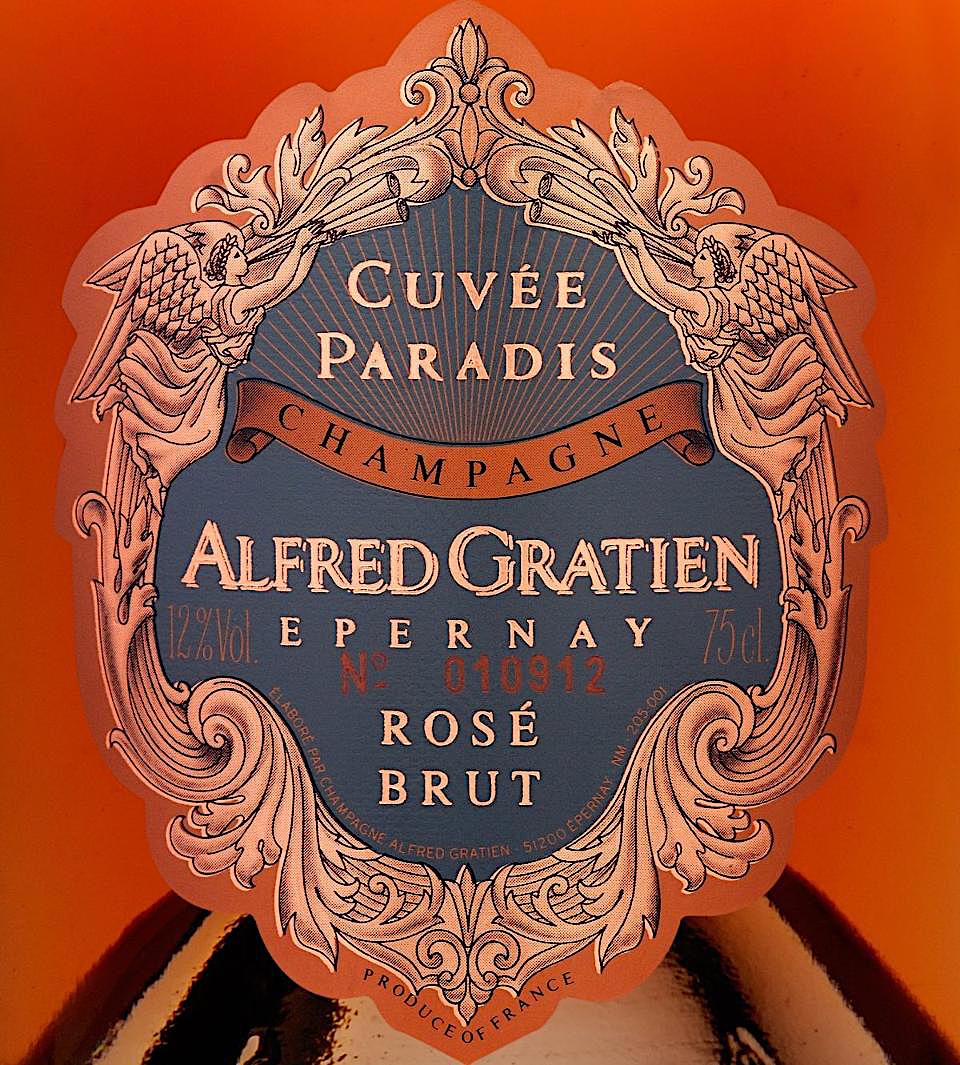 nuts.
nuts.
Alfred
Gratien Brut Rosé ($46)
Made
of 45% Chardonnay, 40% Pinot Meunier and 15%
Pinot Noir, this non-vintage example shows a
bouquet and taste of raspberries and grapefruit
with notes of ginger in its finish. It marries
well with zesty ethnic fare like Mexican, Korean
and Sichuan Chinese specialties.
G.H.
Mumm Brut Rosé ($75)
Perhaps
a bit pricey for a non-vintage sparkler, this
non-vintage bubbly made from 80% Pinot Noir and
20% Chardonnay shows a bouquet and taste of
strawberries, peaches and hints of black cherry
in its vibrant finish that mates particularly
well with shrimp, clams and scallops.
2004 Ruinart “Dom Ruinart” Brut Rosé ($235)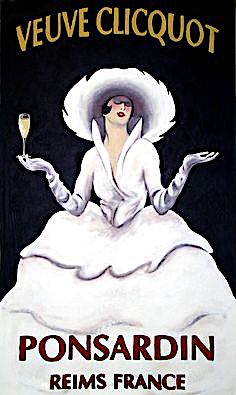
Made
from 81% Grand Cru Chardonnay and 19% Pinot
Noir, this classy wine features a distinctive
bouquet of fading rose petals and a taste of
wild berries with hints of exotic spice and a
crisp, but long lasting taste – perfect to match
with creamy cheeses and delicate seafood dishes.
2006
Veuve Clicquot Grande Dame Rosé ($286)
A
bit pricey, but the grapes (53% Pinot Noir and
47% Chardonnay) all hailed from top name Grand
Cru vineyards. It shows a bouquet of wild
strawberries and some ripe cherry, with an
elegant taste of cherries and cranberries with a
satiny finish. Drink this bubbly with shrimp
specialties and caviar.
And
finally, for those unwilling to pay the price
for rosé Champagne, there’s an excellent bottle
of Italian Rosé available – 2013 Rotari Rose
DOC Trento Sparkling Wine ($17) -made from
25% Chardonnay and 75% Pinot Nero by the same
method as for Champagne. While
it’s not as delicate a true Champagne, and its
flavors don’t linger as long as those of most of
the wines discussed above, it offers a fragrant
bouquet and taste of
apples and raspberries with notes of grapefruit
in its vibrant finish. It is well suited to use
as a toast and marries well with grilled
seafood, pasta with red sauce and veal.
❖❖❖
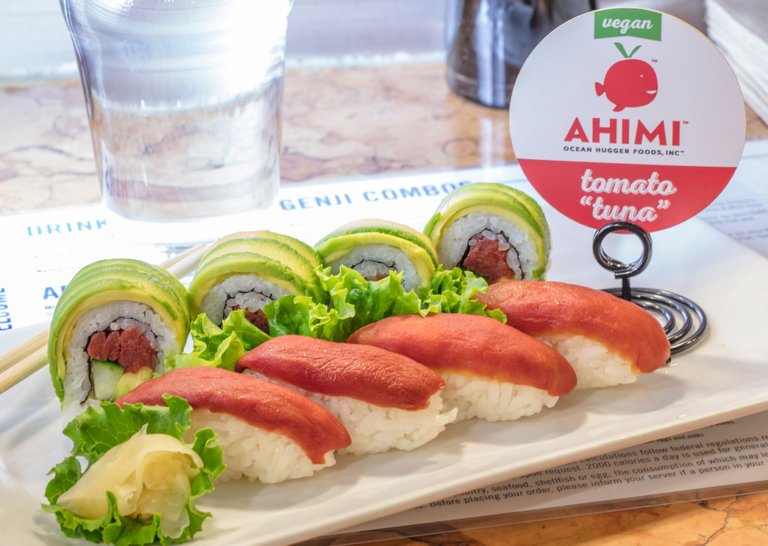 YOU CAN
ALSO EAT THE BOX THEY'RE
YOU CAN
ALSO EAT THE BOX THEY'RE PACKED IN FOR EXTRA UMAMI
Whole Foods Markets in New York and Los Angeles is now selling "faux sushi rolls" called Ahimi, made by Ocean Hugger Foods, whose CEO David Benzaquen says the process removes the "grassy, sweet, and slightly tart flavor from raw tomatoes," resulting in a mass combined with soy sauce to taste like raw tuna.
AH, WHAT WAS IT THE IMMORTAL BARD WROTE?

"SOMETHING FISHY THIS WAY COMES."
"IS THIS A FISH KNIFE WHICH I SEE BEFORE ME?"
"AHI OR NOT AHI?"
“The famed Catania
Market is represented in miniature, Bronx-style, with
eels galore and platinum-toned anchovies, giant mussels
and craggy oysters, not to mention a Shakespearean
repertories’ worth of cephalopods. (Ink, too.)” --Hugh Merwin, "The Absolute
Best Seafood Markets in NY," 11/29/17).
Any of John Mariani's books below may be ordered from amazon.com.
 The Hound in Heaven
(21st Century Lion Books) is a novella, and
for anyone who loves dogs, Christmas, romance,
inspiration, even the supernatural, I hope you'll find
this to be a treasured favorite. The story
concerns how, after a New England teacher, his wife and
their two daughters adopt a stray puppy found in their
barn in northern Maine, their lives seem full of promise.
But when tragedy strikes, their wonderful dog Lazarus and
the spirit of Christmas are the only things that may bring
his master back from the edge of despair.
The Hound in Heaven
(21st Century Lion Books) is a novella, and
for anyone who loves dogs, Christmas, romance,
inspiration, even the supernatural, I hope you'll find
this to be a treasured favorite. The story
concerns how, after a New England teacher, his wife and
their two daughters adopt a stray puppy found in their
barn in northern Maine, their lives seem full of promise.
But when tragedy strikes, their wonderful dog Lazarus and
the spirit of Christmas are the only things that may bring
his master back from the edge of despair. WATCH THE VIDEO!
“What a huge surprise turn this story took! I was completely stunned! I truly enjoyed this book and its message.” – Actress Ali MacGraw
“He had me at Page One. The amount of heart, human insight, soul searching, and deft literary strength that John Mariani pours into this airtight novella is vertigo-inducing. Perhaps ‘wow’ would be the best comment.” – James Dalessandro, author of Bohemian Heart and 1906.
“John Mariani’s Hound in Heaven starts with a well-painted portrayal of an American family, along with the requisite dog. A surprise event flips the action of the novel and captures us for a voyage leading to a hopeful and heart-warming message. A page turning, one sitting read, it’s the perfect antidote for the winter and promotion of holiday celebration.” – Ann Pearlman, author of The Christmas Cookie Club and A Gift for my Sister.
“John Mariani’s concise, achingly beautiful novella pulls a literary rabbit out of a hat – a mash-up of the cosmic and the intimate, the tragic and the heart-warming – a Christmas tale for all ages, and all faiths. Read it to your children, read it to yourself… but read it. Early and often. Highly recommended.” – Jay Bonansinga, New York Times bestselling author of Pinkerton’s War, The Sinking of The Eastland, and The Walking Dead: The Road To Woodbury.
“Amazing things happen when you open your heart to an animal. The Hound in Heaven delivers a powerful story of healing that is forged in the spiritual relationship between a man and his best friend. The book brings a message of hope that can enrich our images of family, love, and loss.” – Dr. Barbara Royal, author of The Royal Treatment.
 |
The Encyclopedia of American Food and Drink by John F. Mariani (Bloomsbury USA, $35) Modesty forbids me to praise my own new book, but let me proudly say that it is an extensive revision of the 4th edition that appeared more than a decade ago, before locavores, molecular cuisine, modernist cuisine, the Food Network and so much more, now included. Word origins have been completely updated, as have per capita consumption and production stats. Most important, for the first time since publication in the 1980s, the book includes more than 100 biographies of Americans who have changed the way we cook, eat and drink -- from Fannie Farmer and Julia Child to Robert Mondavi and Thomas Keller. "This book is amazing! It has entries for everything from `abalone' to `zwieback,' plus more than 500 recipes for classic American dishes and drinks."--Devra First, The Boston Globe. "Much needed in any kitchen library."--Bon Appetit. |
"Eating Italian will never be the same after reading John Mariani's entertaining and savory gastronomical history of the cuisine of Italy and how it won over appetites worldwide. . . . This book is such a tasteful narrative that it will literally make you hungry for Italian food and arouse your appetite for gastronomical history."--Don Oldenburg, USA Today. "Italian
restaurants--some good, some glitzy--far
outnumber their French rivals. Many of
these establishments are zestfully described
in How Italian Food Conquered the World, an
entertaining and fact-filled chronicle by
food-and-wine correspondent John F.
Mariani."--Aram Bakshian Jr., Wall Street
Journal.
"Equal parts
history, sociology, gastronomy, and just
plain fun, How Italian Food Conquered the
World tells the captivating and delicious
story of the (let's face it) everybody's
favorite cuisine with clarity, verve and
more than one surprise."--Colman Andrews,
editorial director of The Daily
Meal.com. "A fantastic and fascinating
read, covering everything from the influence
of Venice's spice trade to the impact of
Italian immigrants in America and the
evolution of alta cucina. This book will
serve as a terrific resource to anyone
interested in the real story of Italian
food."--Mary Ann Esposito, host of PBS-TV's
Ciao
Italia. "John Mariani has written the
definitive history of how Italians won their
way into our hearts, minds, and
stomachs. It's a story of pleasure over
pomp and taste over technique."--Danny Meyer,
owner of NYC restaurants Union Square
Cafe, The Modern, and Maialino.
|
 |
 |
 |
 |
 |
 |
 |
 |
 Everett Potter's Travel Report:
Everett Potter's Travel Report: 
 Eating Las Vegas
JOHN CURTAS has been covering the Las Vegas
food and restaurant scene since 1995. He is
the co-author of EATING LAS VEGAS – The 50
Essential Restaurants (as well as
the author of the Eating Las Vegas web site: www.eatinglasvegas.
He can also be seen every Friday morning as
the “resident foodie” for Wake Up With the
Wagners on KSNV TV (NBC) Channel 3 in
Las Vegas.
Eating Las Vegas
JOHN CURTAS has been covering the Las Vegas
food and restaurant scene since 1995. He is
the co-author of EATING LAS VEGAS – The 50
Essential Restaurants (as well as
the author of the Eating Las Vegas web site: www.eatinglasvegas.
He can also be seen every Friday morning as
the “resident foodie” for Wake Up With the
Wagners on KSNV TV (NBC) Channel 3 in
Las Vegas.

MARIANI'S VIRTUAL GOURMET
NEWSLETTER is published weekly. Editor/Publisher: John
Mariani.
Editor: Walter Bagley. Contributing Writers: Christopher Mariani,
Robert Mariani, Misha Mariani, John A. Curtas, Geoff Kalish, Mort
Hochstein, and
Brian Freedman. Contributing Photographer: Galina
Dargery. Technical Advisor: Gerry McLoughlin.
To un-subscribe from this newsletter,click here.
© copyright John Mariani 2017

